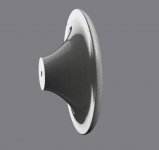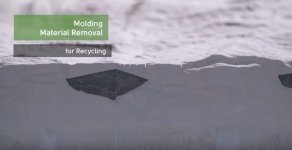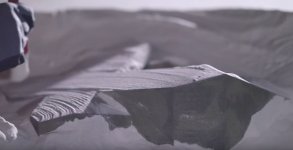The back side stays as you see it, it's really not critical. Or what do you mean?What will you do to backside of the round-over? What thickness in general are you going for using this sand? Sand & epoxi?
They told me they need at least 10 - 12 mm for a part like this not to break during manipulation (to be sure it doesn't).
Last edited:
On the website of the snail enclosure speakers it is stated that they finish with a special layer because else the material is too brittle, are you aware of this? And have you gotten info from the manufacturing company about the possibillities to make the material less brittle?
I can imagine that some sort of epoxy coating could be applied, maybe sprayed on.
I can imagine that some sort of epoxy coating could be applied, maybe sprayed on.
Sure, as I already said, it will be impregnated with epoxy resin. They said it's like stone then. Only during the initial manipulation it may be prone to breaking if too thin.
It's a little hard to see - on one picture it looks like its "filled" - like if you would place it with the mouth down on a table and fill water in it to become like a ring shaped pond.
But maybe its 12 mm everywhere?
//
But maybe its 12 mm everywhere?
//
Probably one of the reasons/advantages (no additional supports needed). See the video, it's fascinating. The print speed and size available is just amazing.
Because of boundary layer separation the surface of devices for fluid dynamics should rather be coarse.I believe it could be made glossy 🙂
So what do you think will be a measurable difference between coarse and smooth/glossy surface?
(We are talking about sub-milimeter coarseness here, just to be clear.)
(We are talking about sub-milimeter coarseness here, just to be clear.)
Last edited:
I don't see how any roughness small compared to a wavelength could have much of an effect acoustically.So gedlee, do we need to polish the inside of a horn/wg or it will sound "course"...?
//
Because of boundary layer separation the surface of devices for fluid dynamics should rather be coarse.
This is true of static flow, but acoustic waves are different and this kind of concept is ill-applied in this situation. There is no static flow, only oscillations.
I have always been interested in porous boundaries as they would have a big effect on all but waves parallel to the surface (the zero mode). In this later case the effect would be smallish, but for HOMs it would be large.
Last edited:
Some informative stuff
But no comments on this post?
Acoustic Horn Design – The Easy Way (Ath4)
Best wishes
David
Last edited:
- Home
- Loudspeakers
- Multi-Way
- Acoustic Horn Design – The Easy Way (Ath4)



